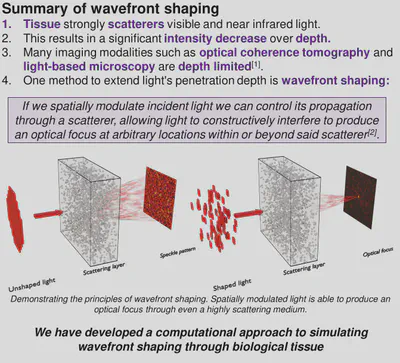Efficient full-wave simulation of wavefront shaping to focus light through biological tissue

Biological tissue strongly scatters visible and near-infrared light, resulting in a significant reduction in intensity at depth. As a result, imaging modalities such as optical coherence tomography or photoacoustic microscopy are constrained to image superficial tissues. One method to extend the penetration depth of light in these modalities is wavefront shaping (WFS) - a technique in which the incident light is spatially modulated to control its propagation through scattering media, potentially allowing light to be focused at arbitrary locations within tissue.
Computational methods for simulating WFS could complement experimental investigation, which is often constrained by a lack of control. For example, with computational approaches it becomes possible to evaluate the field inside a given medium, resolve both amplitude and phase information, and fully manipulate the optical properties and geometry of said medium. Unfortunately, current approaches to simulate light propagation through biological tissue are either too computationally intensive to model volumes large enough to significantly benefit from WFS, or too incomplete to model underlying deterministic scattering and interference processes accurately.
We propose coupling the T-matrix method with the discrete particle model to create an efficient but rigorous simulation of light propagation through biological tissue. The T-matrix method works by propagating light through a medium of scattering particles such that the total field is a superposition of the scattered fields associated with each sphere, creating a solvable matrix system. By controlling the density, radii, and refractive indices of these spheres we are able to design bespoke domains with desired optical properties potentially matching those of tissue.
To simulate the complex beams found in WFS we apply the angular spectrum method whereby arbitrary beams can be decomposed into a spectrum of plane waves incident at varying angles which can be simulated sequentially. In this manuscript we demonstrate how our T-matrix discrete particle approach coupled with an angular spectrum decomposition of the incident field can be used to efficiently simulate optical foci generation through turbid media. We begin by replicating the original Vellekoop and Mosk WFS experiment by simulating the generation of an optical focus through a titanium dioxide scattering layer. We then simulate focus generation through a tissue-like 100µm3 sample volume.